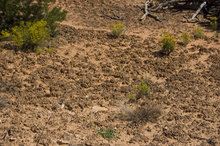- Cryptobiotic soil
-
 Cryptobiotic soil in Hovenweep National Monument.
Cryptobiotic soil in Hovenweep National Monument.
 Cryptobiotic soil crust in Natural Bridges National Monument near Sipapu Bridge.
Cryptobiotic soil crust in Natural Bridges National Monument near Sipapu Bridge.
A Cryptobiotic soil is a biological soil crust composed of living cyanobacteria, green algae, brown algae, fungi, lichens, and/or mosses. Commonly found in arid regions around the world, cryptobiotic soils go by many names, including cryptogamic, microbiotic, or microphytic soils or crusts. Soil crusts are important members of desert ecosystems and contribute to the well-being of other plants by stabilizing sand and dirt, promoting moisture retention, and fixing atmospheric nitrogen.
Because of their thin, fiberous nature, cryptobiotic soils are extremely fragile systems. A single footprint or tire track is sufficient to disrupt the soil crust and damage the organisms. While some species within the soil crust system may regrow within a few years of a disturbance, the damage to slow-growing species may require more than a century before the delicate soil returns to its former productivity.
This sensitivity to disturbance means that travelers in arid regions should be mindful of their impact on cryptobiotic soils. As a general rule, visitors should stay on pre-existing roads and trails, only traveling off-trail on durable surfaces such as bedrock or river gravel.
See also
 Media related to Cryptobiotic soil at Wikimedia Commons
Media related to Cryptobiotic soil at Wikimedia Commons
References
- Biological soil crusts, USGS Canyonlands Research Station
- Cryptobiotic soils, USGS
Categories:- Ecology stubs
- Soil biology
- Lichens
Wikimedia Foundation. 2010.
